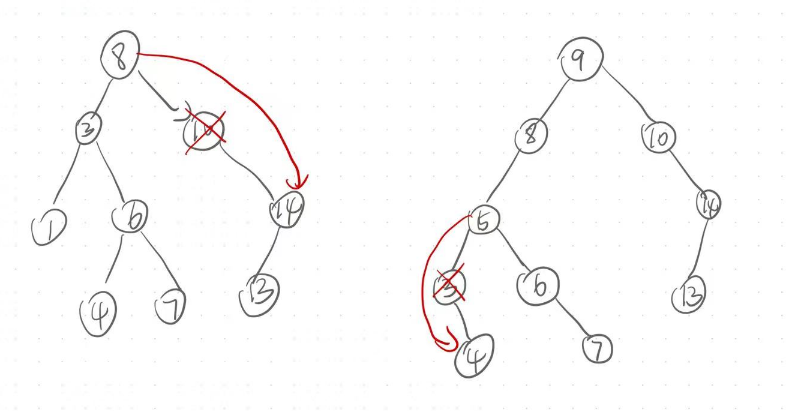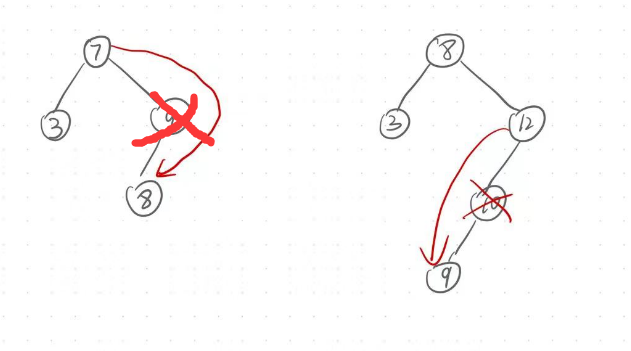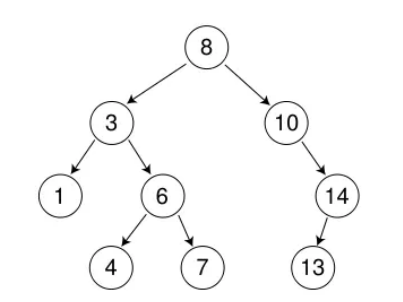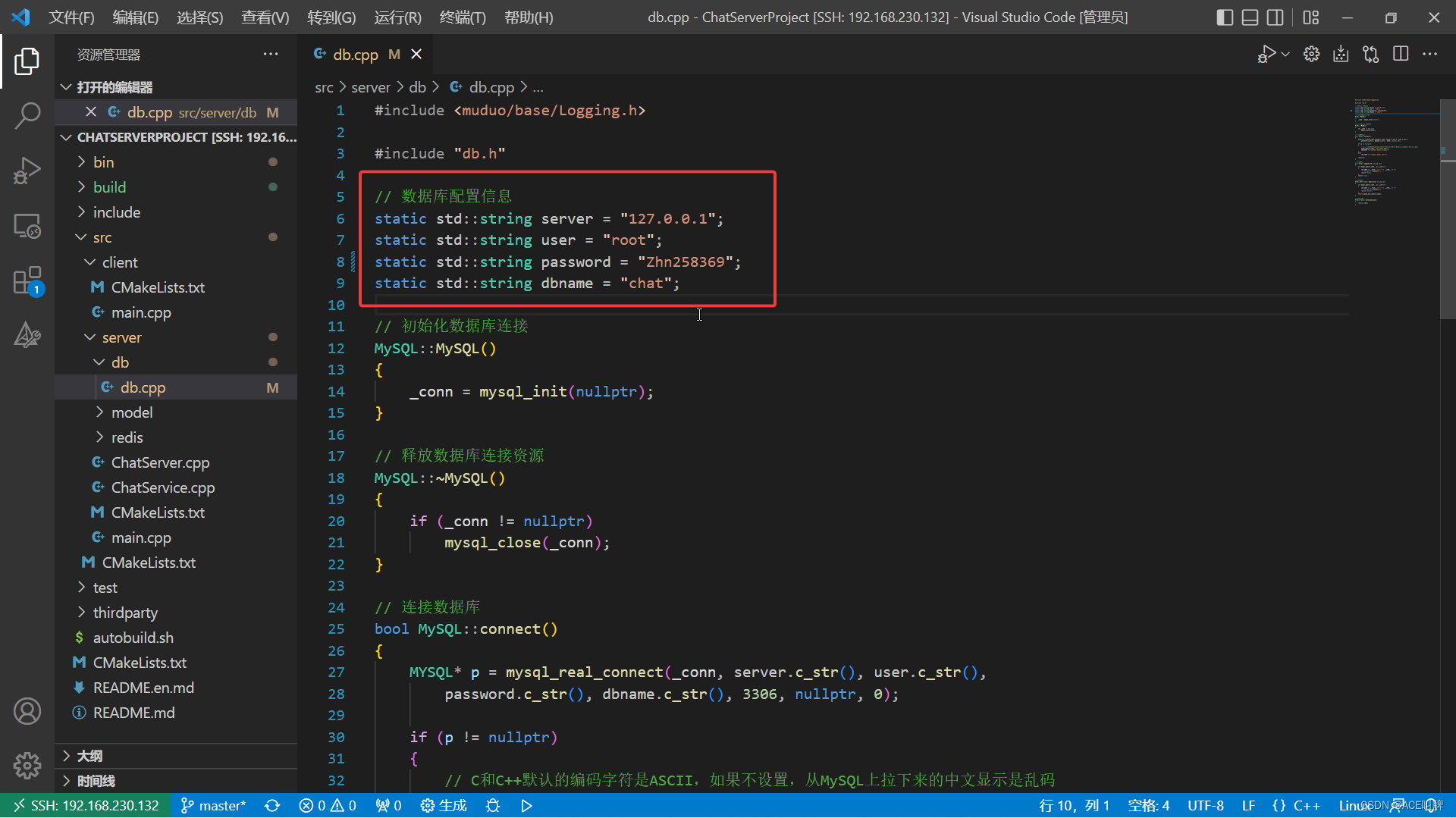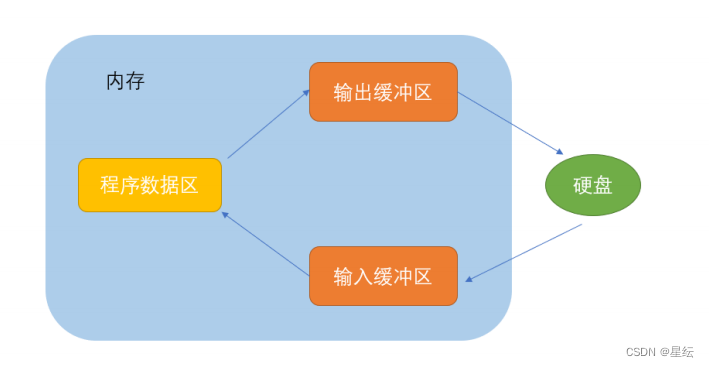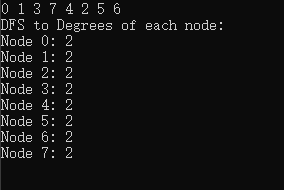搜索二叉树
定义
搜索二叉树:左子树小于根,右子树大于根.搜索二叉树的中序序列是升序的.所以对于二叉树而言,它的左子树和右子数都是二叉搜索树
下图就是二叉搜索树
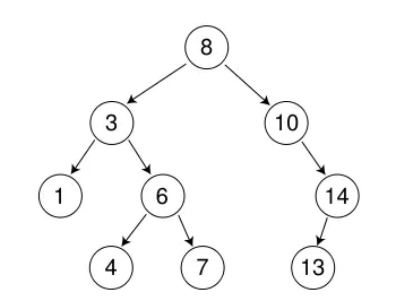
二叉搜索树的性质:
- 二叉搜索树的中序遍历出的数据是有序的,并且二叉树搜索树在查找某个数的时候,一般情况下的时间复杂度是O(log2(N))级别的.
- 二叉搜索树中是没有值相同的节点的,否则无法构成二叉搜索树.
节点的定义
二叉树和别的树的区别就是各个节点的排列有了区别,节点中存储的内容还是不会变的,仍然是左右指针,和一个值.
template<class K>
struct BinarySearchTreeNode
{typedef BinarySearchTreeNode<K> Node;Node* _left;Node* _right;K _key;BinarySearchTreeNode(const K& key): _left(nullptr), _right(nullptr), _key(key){}
};
节点的构造方法
BinarySearchTreeNode(const K& key): _left(nullptr), _right(nullptr), _key(key){}
二叉搜索树的创建
二叉搜索树的创建首先只需要一个根节点即可,后续插入节点或者删除节点时,保持住连接关系就好.
template<class T>
class BinarySearchTree
{typedef BinarySearchTreeNode<K> Node;private:Node* _root = nullptr;public:// 各种函数
};
注意:后边的这些方法都是写在类的public中的.
向树中插入节点
例如:插入节点A的时候,要判断A中的key值和树中根节点开始,依次比较key值,我们定义一个cur指针,用于为新来的节点找到合适的插入位置,假如A节点的key值<cur节点的key值,那么就cur就向左树开始遍历.假如A的key值和cur的key值相同,直接返回.假如A的key值大于cur的key值,cur就向右数遍历.最终cur的位置就是能插入数据的地方,但是cur的值最后是为空的,那么我们如何将cur处的值替换为这个A节点呢?换句话说,如何让cur的父节点指向这个A节点呢?答案是:我们在cur向下一个节点行进之前,先保存当前节点的指针,也就是保存好cur的父节点的值.
但是A节点最终是链接在父节点的左边还是在父节点的右边呢??这个只能通过保存的父节点中保存的值进行判断.若A节点的值小于父节点,那么就链接在父节点的左边,否则链接在父节点的右边.
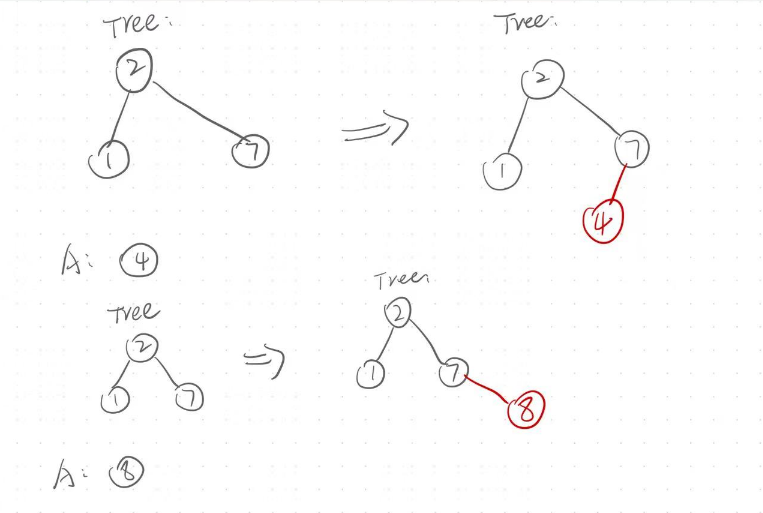
代码实现:
bool insert(const K& key)
{// 插入节点之前,检查是不是空树if(_root == nullptr){_root = new Node(key);return true;}Node* cur = _root;Node* parent = _root;while(cur){if(key<cur->_key){parent = cur;cur = cur->_left;}else if(key>cur->_key){parent = cur;cur = cur->_right;}else{// 值不能相同直接返回return false;}}if(parent->_key<key){parent->_left = new Node(key);}else{parent->_right = new Node(key);}return true;
}
查找元素
查找元素就比较简单了,要查找的值小于cur的当前值,那么就向左树查找,若大于当前值,就向右数查找.
代码实现:
bool find(const K& key)
{Node* cur = _root;while(cur){if(key<cur->_key){cur = cur->_left; }else if(key>cur->_key){cur = cur->_right;}else{return true;}}return false;
}
删除元素
二叉搜素树中,删除节点是最比较复杂的.分为了3种情况
要被删除的目标节点的左树是空:每次cur指针在找目标节点时,每次cur迭代之前,都需要记录cur的当前位置,也就是用parent指针来记录.
- 当删除的节点是parent的右边时:就需要parent的右指针指向目标节点的右子树.
- 当删除的节点是parent的左边时:就需要parent的左指针指向目标节点的右子树.
要被删除的节点的右树是空:每次cur指针在找目标节点时,每次cur迭代之前,都需要记录cur的当前位置,也就是用parent指针来记录.
- 当删除的节点是parent的右边时:就需要parent的右指针指向目标节点的左子树.
- 当删除的节点是parent的左边时:就需要parent的左指针指向目标节点的左子树.
要被删除的节点的左右都不是空的时候:
此时就需要用替换法了,
例如:我们要删除下图中的值为8的节点.删除节点但是不能破环二叉搜索树的结构,所以就需要找到一个值在3和10的节点来替换这里的值为8的节点.那么这值如何找呢?由于二叉搜索树的结构可知,左树的值小于根的值,右树的值总是大于根的值.所以我们可以在左树中找到最大的值或者是在右树中找到最小的值(这两个值的任意一个值都是符合要求的,即大于3小于10的)来替换要被删除节点的位置的值,如下图,就可以将7复制到8这个位置,紧接着删除原本的7所在的节点,就删除成功了.注意:删除原本值为7的节点时,一定属于第一种和第二种情况之一,因为:左树的最大值的右指针一定为空,右数的最小值的左树一定为空.
代码实现:
bool erase(const K& key)
{Node* cur = _root;Node* parent = _root;while(cur){if(key<cur->_key){parent = cur;cur = cur->_left;}else if(key>cur->_key){parent = cur;cur = cur ->_right;}else{// 删除的节点的左树为空if(cur->_left == nullptr){if(cur == _root){_root = _root->_right;}else{if(parent->_right == cur){parent ->_right = cur->_right;}else{parent->_left = cur->_right;}}delete cur;return true;}// 删除的节点的右树为空else if(cur->_right == nullptr){if(cur == _root ){_root = _root ->_left;}else{if(parent->_right == cur){parent->_right = cur->_left;}else{parent->_left = cur->_left;}}delete cur;return true;}// 左右都不为空,替换法else{// 以右边的最小值为例子Node* rightMinParent = cur;Node* rightMin = cur->_right;while(rightMin->_left){rightMin = rightMin ->_left;}cur->_key = rightMin->_key;if(rightMinParent->_left == rightMin){rightMinParent->_left = rightMin->_right;}else{rightMinParent->_right = rightMin->_right;}delete rightMin;return true;}}}return false;
}
二叉树的中序遍历
由于类的成员函数不能递归调用,所以创建一个私有函数_Inorder,接着在public中定义Inorder方法,调用这个_Inorder犯法即可.
void Inorder()
{_Inorder(_root);
}
void _Inorder(Node* root)
{if(root==nullptr) return;_Inorder(root->_left);cout<<root->_key<<endl;_Inorder(root->_right);
}
二叉搜索树的递归找数字
bool _Find(Node* root,const K& key)
{if(root == nullptr) return false;else if(root->_key == key) return true;else if (root->_key < key){_Find(root->_right, key);}else{_Find(root->_left, key);}
}
二叉搜索树删除元素的另一种方法
这里的root定义成引用即可,root必定是节点的左指针或者右指针的引用.这里直接改变引用的值即可.就不用找父节点了.更方便一点.
bool _Erase(Node*& root, const K& key){if (root == nullptr){return false;}if (root->_key < key){return _Erase(root->_right, key);}else if (root->_key > key){return _Erase(root->_left, key);}else{Node* del = root;if (root->_right == nullptr){root = root->_left;}else if (root->_left == nullptr){root = root->_right;}else{// 替换法Node* rightMin = root->_right;while (rightMin->_left){rightMin = rightMin->_left;}swap(rightMin->_key, root->_key);// 将当前root位置和rightMin位置的值进行交换,接着在root的右边的树中删除keyreturn _Erase(root->_right, key);}delete del;return true;}}
二叉搜索树插入数据的第二种方式
// 注意这里的&是不可少的,不然要使用二级指针进行操作了.bool _Insert(Node*& root, Node* parent, const K& key){if (root == nullptr){root = new Node(key);}if (root->_key > key){return _Insert(root->_left, parent, key);}else if (root->_key < key){return _Insert(root->_right, parent, key);}else if (root->_key == key){return false;}}
二叉搜索树的构造方法
拷贝构造
先拷贝根,再拷贝左右子树
Node* Copy(Node* root)
{if(root == nullptr)return nullptr;Node* newRoot = new Node(root->_key);newRoot->_left = Copy(root->_left);newRoot->_right = Copy(root->_right);return newRoot;
}
// 在构造函数中:
BinarySearchTree(BinarySearchTree<K>& t){this->_root = Copy(t._root);
}
赋值拷贝
注意:要使用如下这种方法,参数必须是类实体,不能是类引用,返回值必须是类引用.
BinarySearchTree<K>& operator=(const BinarySearchTree<K> t)
{swap(t._root,this->_root);return *this;
}
默认构造
BinarySearchTree() = default;
析构函数
先写一个destroy函数
~BinarySearchTree()
{Destroy(_root);
}
void Destroy(Node* root)
{if(root== nullptr)return ;Destroy(root->_left);Destroy(root->_right);delete root;
}
源码
#include<iostream>
using namespace std;
namespace key
{template<class K>struct BinarySearchTreeNode {typedef BinarySearchTreeNode<K> Node;Node* _left;Node* _right;K _key;BinarySearchTreeNode(const K& key):_left(nullptr), _right(nullptr), _key(key){}};template<class K>class BinarySearchTree {typedef BinarySearchTreeNode<K> Node;public:bool Erase(const K& key) // 删除指定的节点.{Node* cur = _root;Node* parent = _root;while (cur){if (cur->_key == key){if (cur->_right == nullptr){if (cur == _root) {_root = _root->_left;}else{if (cur == parent->_left){parent->_left = cur->_left;}else{parent->_right = cur->_left;}}delete cur;return true;}else if (cur->_left == nullptr){if (cur == _root) {_root = _root->_right;}else{if (cur == parent->_left){parent->_left = cur->_right;}else{parent->_right = cur->_right;}}delete cur;return true;}// 左右都不为空的时候使用替换法else{Node* rightMinParent = cur; // 这里要用cur进行初始化// 右边的最小值Node* rightMin = cur->_right;while (rightMin->_left){rightMinParent = rightMin;rightMin = rightMin->_left;}cur->_key = rightMin->_key;if (rightMin == rightMinParent->_left)rightMinParent->_left = rightMin->_right;elserightMinParent->_right = rightMin->_right;delete rightMin;return true;}}else if (cur->_key > key){parent = cur;cur = cur->_left;}else{parent = cur;cur = cur->_right;}}return false;}void Inorder(){_Inorder(_root);}bool Insert(const K& k){if (_root == nullptr){_root = new Node(k);return true;}Node* cur = _root;Node* parent = nullptr;while (cur){if (cur->_key == k){return false;}else if (cur->_key > k){parent = cur;cur = cur->_left;}else{parent = cur;cur = cur->_right;}}//保存父节点if (k < parent->_key){parent->_left = new Node(k);}else{parent->_right = new Node(k);}return true;}bool Find(const K& k){Node* cur = _root;while (cur){if (cur->_key == k){return true;}else if (cur->_key > k){cur = cur->_left;}else{cur = cur->_right;}}return false;}bool FindR(const K& key) //递归找数字{return _Find(_root, key);}bool InsertR(const K& key){return _Insert(_root, _root, key);}bool EraseR(const K& key){return _Erase(_root, key);}~BinarySearchTree(){Destroy(_root);}// 自动生成默认的构造BinarySearchTree() = default;// 拷贝构造BinarySearchTree(const BinarySearchTree<K>& t){this->_root = Copy(t._root);}// 赋值拷贝BinarySearchTree<K>& operator=(const BinarySearchTree<K> t){swap(_root, t._root);return *this;}private:Node* Copy(const Node* root){if (root == nullptr)return nullptr;Node* newRoot = new Node(root->_key);newRoot->_left = Copy(root->_left);newRoot->_right = Copy(root->_right);return newRoot;}void Destroy(Node*& root){if (root == nullptr)return;Destroy(root->_left);Destroy(root->_right);delete root;}bool _Erase(Node*& root, const K& key){if (root == nullptr){return false;}if (root->_key < key){return _Erase(root->_right, key);}else if (root->_key > key){return _Erase(root->_left, key);}else{Node* del = root;if (root->_right == nullptr){root = root->_left;}else if (root->_left == nullptr){root = root->_right;}else{// 替换法Node* rightMin = root->_right;while (rightMin->_left){rightMin = rightMin->_left;}swap(rightMin->_key, root->_key);// 将当前root位置和rightMin位置的值进行交换,接着在root的右边的树中删除keyreturn _Erase(root->_right, key);}delete del;return true;}}// 注意这里的&是不可少的,不然要使用二级指针进行操作了.bool _Insert(Node*& root, Node* parent, const K& key){if (root == nullptr){root = new Node(key);}if (root->_key > key){return _Insert(root->_left, parent, key);}else if (root->_key < key){return _Insert(root->_right, parent, key);}else if (root->_key == key){return false;}}Node* _root = nullptr;void _Inorder(Node* root){if (root == nullptr)return;_Inorder(root->_left);cout << root->_key << " ";_Inorder(root->_right);}bool _Find(Node* root, const K& key) {if (root == nullptr)return false; else if (root->_key == key)return true; else if (root->_key < key) {_Find(root->_right, key); }else {_Find(root->_left, key); }}};
}
结束
本篇文章就到这里就结束啦,若有不足,请在评论区指正,下期再见,
